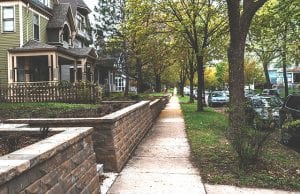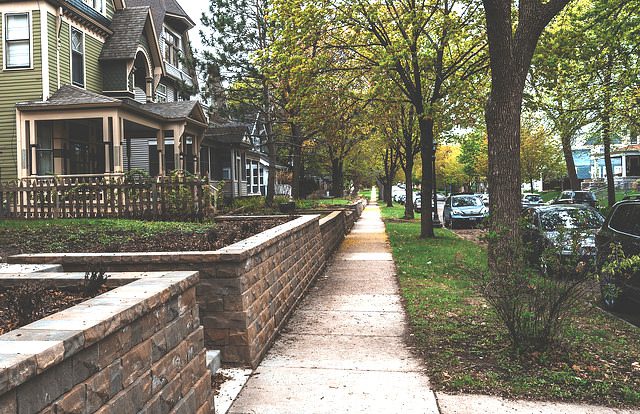
‘City Sidewalk, Saint Paul, Minnesota.’ Photo by Tony Webster via flickr, CC BY 2.0
The stories we tell ourselves matter. Narrative plays an important role in defining whose voice gets heard, how issues are framed, and what solutions are developed.
The year 2018 marked 50 years since the Fair Housing Act was passed, and a big question among housing advocates was, are we closer to achieving fairness and equity when it comes to housing?
Minnesota, a state that always makes the top of the list as one of the best places to live in the nation, also consistently ranks among the worst nationwide for people of color. The white population in the state is 79 percent, while people of color account for 21 percent, and racial disparities exist across all indicators. When researchers used statistical modeling to adjust for demographic and other differences, the analysis found that while demographic differences are partly responsible, many disparities remained even when demographic differences were removed—concluding that race and ethnicity are the key driving factors to disparities in accessing opportunity.
Homeownership rates display some of the greatest disparity. Minnesota has among the highest homeownership in the nation, but when the numbers are disaggregated, white homeownership is at 75.7 percent compared to 24.1 percent for people of color. The past five years have seen a robust debate in addressing housing issues.
In 2010, the Metropolitan Council was awarded a three-year $5 million Sustainable Communities Regional Planning Grant by the U.S. Department of Housing and Urban Development (HUD). The Metropolitan Council is the regional policy-making body, planning agency, and provider of essential services for the Twin Cities Metropolitan region. The council’s mission is to foster efficient economic growth for the region.
Because equity and access are critical underpinnings of the Sustainable Communities program, HUD required each grantee to complete a Fair Housing and Equity Assessment (FHEA). A Fair Housing and Equity Assessment involves analyses of a region’s racial and ethnic diversity, identifying Racially Concentrated Areas of Poverty (RCAPs) and High Opportunity areas, and describing public investments and policies as well as the jurisdiction’s fair housing landscape.
Due to the importance of this document and its influence on the Metropolitan Council’s long-range planning, housing advocates found it important to weigh in. The Fair Housing Equity Analysis Table was convened by The Alliance for Metropolitan Stability and the Center for Urban and Regional Affairs. The table was composed of grassroots organizations across the metro area that work in communities most affected by equity disparities. I participated in this work as executive director of the African Career Education and Resource Inc., a nonprofit organization that engages African immigrants living in the north and northwest suburbs of Minneapolis to advance equity and eliminate disparities for the area’s large and growing African community. The table, through advocacy and relationship building with some council members, lobbied to be able to offer input and have influence on the document.
The Fair Housing Equity Analysis Table pushed and challenged the council to do proper community engagement in order to incorporate the voices of the people who would be most affected by its recommendations. We also engaged the federal HUD office to hold it as accountable as the grant administrators to ensure that the work was done right.
An important part of the work we did was ensuring that a true analysis was done. As is typical with many institutions that address issues of poverty, the initial draft named the problem extensively without digging deeper into its root causes. There is a typical pattern of talking about poor areas and poor people without analyzing the historical context leading to these situations, which results in placing the blame on the group that is impacted and implying that their existence is the problem, when the real problem is the disinvestment that happens when people of color and low income people choose to live together.
The narratives about these communities usually focus on the negative: their poverty, low-performing schools, etc. Through our work and experience, however, we know that the people who live in these communities benefit from the cultural connections and social networks they create, and wanted to recognize that in the report. For example, in my community of Brooklyn Park and Brooklyn Center, which have some of the fastest growing Racially Concentrated Areas of Poverty, there are many ethnic microbusinesses—immigrant-owned enterprises that provide culturally specific goods and services—that are able to thrive because of the critical mass of immigrant residents. Another thing to note about communities like these is that in Minnesota, they are the only areas where candidates of color have been successful getting elected to office.
The term RCAP is largely used in the housing and economic development world and refers to areas that have 50 percent or more people of color and 40 percent or more people living at or below the poverty level. Because of the resulting disinvestment, they usually end up being defined as areas of no or low opportunity, based on indicators of education level, school performance, health outcomes, life expectancy, and economic development.
The remedy is oftentimes to use various means to steer people into “opportunity areas” where they may be better able to prosper in the aforementioned indicators. There is usually a push to cease any new production of affordable housing in these neighborhoods, even if residents might be housing-cost burdened and still have a need for it, in favor of moving them out and into opportunity areas. What this remedy implies is that the dilution of the concentration of poor people is the solution, and it absolves systems of coming up with solutions and strategies that will lift people out of poverty. When the analysis is only on a spatial level and not centered on people, we miss the mark. Places are not discriminated against—people are.
The Fair Housing Equity Analysis Table also highlighted the failure of systems to name racially concentrated areas of wealth as also being segregated, as these tend to be mainly affluent white communities. In identifying areas with white concentrations of wealth, we sought to dispel the myth that some areas are poor because people of the same race live together and that certain races prosper when they live together. The real reason why communities of color living together are poor is because of the discrimination that occurs when these communities choose to live together, and that is what needs to be solved for.
Finally, we asserted that those who are most impacted by a problem have the best solution. For example, residents in the named RCAP areas had clearly stated they loved where they lived, but wanted their living conditions to be better. People’s lived experiences must be incorporated in the decision-making process. Through tenant organizing, organization-affiliated members of the table were able to work on ordinances to strengthen tenant protections and continue to preserve affordable housing in the long run. We incorporated a lot of storytelling, and these stories shaped the narrative and focus of our work, as well as the solutions that we wanted to be pursued.
The Metropolitan Council changed the term RCAP in January 2015 as a result of our work together. Now, areas of concentrated poverty where 50 percent or more of residents are people of color are referred to as ACP50. They also produced a very robust and strong analysis document as a result of working with the community. It is a great success story of how institutions and communities can work together. The Fair Housing Equity Analysis Table has evolved into the Equity In Place table. The table continues to be a critical voice and contributor to the regional conversation on Housing and Economic Development and in raising the voices of impacted community members.






Nelima: In the old days, they called the response to the situation’ in Brooklyn Park and Brooklyn Center, you described in your article, “community development”. It worked pretty well and it was a lot of fun too, but it tended to be a bit messier than having social service professionals, urban planners and bank underwriters decide what to do, so this approach lost favor; as the groups practicing it, encouraged by those who funded their work, began specializing in one “line of business” such as doing LIHTC deals, small business lending, etc. Here in the Twin Cities there are a few organizations such as: Redesign, in the Seward neighborhood of Minneapolis; and Dayton’s Bluff Neighborhood Housing Services and the East Side Neighborhood Development Company, on the East Side of St. Paul, that still practice this archaic art of “community development”. In the late 1980s, there was even a State funded program called the Urban Revitalization Action Program that provided significant financial resources to support these efforts. It’s still on the books. A couple years back, when the State of Minnesota launched its “equity investment initiative” a few of us advocated for a community development approach, that targeted the poor neighborhoods, but alas, specialization won the day; and those who had the most effective lobbyists got all of the funding.
@Jim Erchual
Community development is still very much alive and well where I live. We have all that you describe. I am a community development specialist in local government.
@Nelima Sitati Munene
I gave a presentation on “Homelessness and Redlining” just last Friday, and I was thinking about some of the same things that this article mentioned. The reasoning behind fighting segregation and the impact of redlining still felt today is to give people the opportunities to live and work where they choose to. Choice includes the ability to live spread out as well as concentrated in areas where people share similarities. Dilution is not really the goal, but often an expected outcome. Good point though, I think many people have forgotten the actual goals and instead look for the expected outcomes.
Most minorities and many poor people really didn’t have a choice where they got to live due to segregation and redlining. While redlining now is officially illegal and has been illegal for decades, most of the affordable housing stock was built during the times of segregation and redlining, so we still have the impact today of those times. Neighborhood boundaries may easily go all the way back to the 1800s in many locations. “Know your place” aggression was reality. Redlining helped support extreme community disparities, and created artificial housing values.
I think many of the community remedies are actually fine, but they were implemented too late to have much of an impact. However, I would not give up on community remedies, just a reality check that the redlining still impacts us today, and that the best community remedy may be to offer opportunities to everyone sometimes. I think the bigger problem, now and then, is that minorities are often not listened to about what they want.
Nelima: After working in community development for the last 40 years I find your analysis of “moving to opportunity” to be exactly right. Equity in Place is also right. Providing resources directed by residents of the neighborhoods that have been affected by decades of discrimination is the only way to right those wrongs.
Jim: we’re old enough to know that there was a more progressive community development era before the advent of our current neoliberal reality. It sounds like Nelima and her colleagues are working their way toward it in their own way.